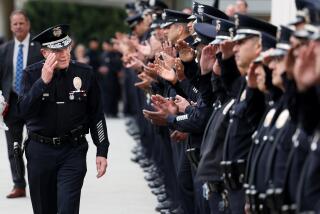Florida Shrine Honors Police Officers Killed Since 1960
- Share via
NORTH PORT, Fla. — Somebody killed a policeman today,
In your town or mine,
While we slept in comfort behind locked doors,
A cop put his life on the line . . .
--Anonymous
Law enforcement officers from every state and from many foreign nations have made pilgrimages to this small town for 30 years.
They come to visit the American Police Museum Hall of Fame, where they pay tribute to all the law enforcement officers who, since 1960, have given their lives in the line of duty in the United States. Thousands of spouses, children, parents, grandparents, brothers, sisters, other relatives and friends also come to the museum to honor and remember their loved ones.
Inscribed on plaques on the walls of a memorial hall in this shrine to America’s police are the names, ranks and departments of the more than 3,400 officers.
Dennis Wilkins, 48, chief of the Ross Township Police Department in Augusta, Mich., scanned the names on the memorial walls with his wife, Mary, and remarked: “But for the grace of God, there I am.”
He was emotionally overwhelmed, as are most officers who come here.
“Thoughts race through my mind as I read these names, and the names of the small towns and large cities these men and women served. Why? What happened? What were the circumstances of his or her death?” mused Wilkins.
Said his wife: “I feel very sad being in this room, sad for their loved ones they left behind. For me, it is a special sadness because my husband is a policeman and so is our son.”
After this week, the pilgrimages to North Port, 40 miles south of Sarasota, by officers, relatives and friends will end. The American Police Museum Hall of Fame is relocating to larger quarters in Miami. The new shrine to America’s law enforcement officers will open May 5 at what had been the FBI’s Miami headquarters.
“We ran out of space,” explained Gerald Arenberg, founder-director of the Police Hall of Fame. “Our new building will be three stories, 10 times the size of our present location.”
He noted that the new memorial will include a chapel.
“Each of the more than 3,400 names is being inscribed in 3-foot-long, inch-high sections of 10-foot-high marble panels in a cathedral-like room. It will be our equivalent of the Vietnam memorial wall in Washington,” said Arenberg.
The names are now on small plastic plaques.
Each year a memorial service May 15 attracted officers and surviving family from throughout the nation to the Police Hall of Fame in North Port.
This May 15, proclaimed National Police Memorial Day by President Bush, a memorial program will take place at the new Hall of Fame in Miami.
“The Hall of Fame serves as a support organization for the families of officers killed while on duty,” Arenberg said. “We send a special newsletter to the survivors every two months. We encourage family members who have gone through the sorrow of losing someone to exchange meaningful letters with those recently affected.”
When Arenberg was a young officer with the Golf, Ill., police in 1955, he was nearly killed by a driver he says was drunk.
“As I recovered in the hospital, the idea struck me of having a National Police Hall of Fame,” he said.
Five years later, his dream came true. By then, he was chief of police in the small Chicago suburb.
The American Police Museum Hall of Fame since its inception has been owned and operated by the 11,000-member National Assn. of Chiefs of Police. Arenberg is the hall’s unpaid director and is executive director of the 75,000-member American Federation of Police.
In North Port, the Hall of Fame--with its 25-foot-tall sign in the shape of a police officer--has become a landmark.
An original Chester Gould drawing of Dick Tracy greets visitors inside the museum, which is filled with artifacts relating to law enforcement officers, criminals and victims.
There is an electric chair, a guillotine, counterfeit money, hundreds of police agency arm patches, helmets from around the world, uniforms, handcuffs, leg irons, firearms, radios, sirens, cruisers and motorcycles. All will be relocated to Miami, with many more items moving from storage to display now that the museum will have more space.
Graphics in the museum include a startling tabulation of crime facts: 2,250,000 serious crimes committed in the United States each year at a cost of $27 billion to taxpayers. Crimes since 1958 increased five times faster than the population.
On average, three officers are killed each week, with hundreds injured. A murder occurs nearly every hour of every day, a robbery every five minutes.
Another display at the museum notes that 600,000 officers serve America, 8% of whom are women. The officers work for 16,000 municipal, 3,000 county sheriff, and 1,200 federal and state agencies.
And from the ranks of those law enforcement officers, many will give their lives.
In memoriam, their names will be inscribed in the new American Police Museum Hall of Fame in Miami.
More to Read
Sign up for Essential California
The most important California stories and recommendations in your inbox every morning.
You may occasionally receive promotional content from the Los Angeles Times.













